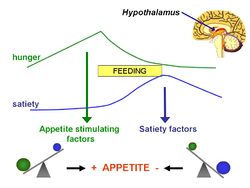Revision as of 05:23, 10 October 2011 by imported>Sophie Rajska
All unapproved Citizendium articles may contain errors of fact, bias, grammar etc. A version of an article is unapproved unless it is marked as citable with a dedicated green template at the top of the page, as in this version of the 'Biology' article. Citable articles are intended to be of reasonably high quality. The participants in the Citizendium project make no representations about the reliability of Citizendium articles or, generally, their suitability for any purpose.
 
For the course duration, the article is closed to outside editing. Of course you can always leave comments on the discussion page. The anticipated date of course completion is 01 April 2012. One month after that date at the latest, this notice shall be removed.
Besides, many other Citizendium articles welcome your collaboration!
|
In 1953, Kennedy [1] proposed what became known as the lipostatic hyothesis. Specifically, he postulated the existence, in the hypothalamus, of a centre that was sensitive to the concentration of metabolites in the circulation, which prevented "an overall surplus of energy intake over expenditure."
References
- ↑ Kennedy GC (1953) The role of depot fat in the hypothalamic control of food intake in the rat Proc R Soc Lond B Biol Sci 140:578-92 [1]
Sophie Rajska 11:21, 10 October 2011 (UTC)
www.maximivanov.com/nutrition2.doc
http://ajpregu.physiology.org/content/286/1/R14.full
http://ajpregu.physiology.org/content/292/1/R37.full
